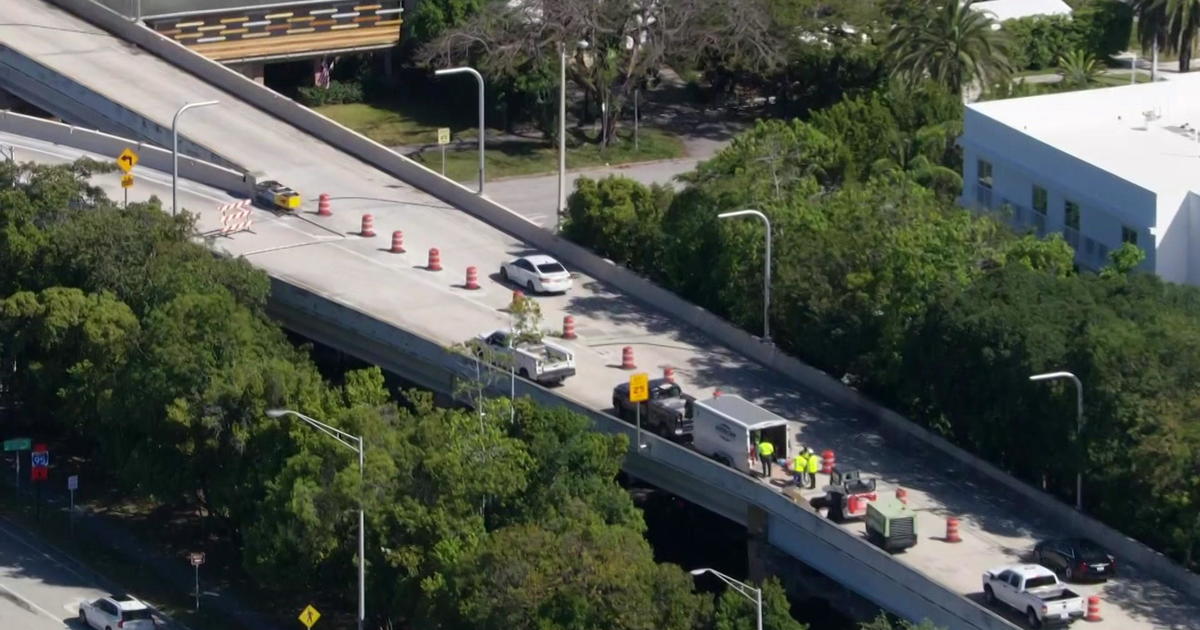I-Team: Behind The Scenes Of Near Train Collision
A CBS4 I-Team investigation into your safety now finds that a trainee and engineer in a southbound Amtrak train attempted to keep a near collision with a northbound Tri-Rail train quiet. The engineer admitted to authorities that he went as far as keeping his own conductor and other crew members in the dark about what happened.
That information is contained in statements given by train crew members to train officials obtained by the CBS4 I-Team.
Last month the I-Team first uncovered the near collision between the two South Florida commuter trains and the attempted cover-up that followed. I-Team investigator Stephen Stock talked for the first time with the single person responsible for blowing the whistle on the incident. And the I-Team has details of the statements given by those directly involved in the incident back on October 20, 2008.
I-Team Related Links
Interview with Shawn Furniss
Interview with Patty Beal
Amtrak Crew Interviews
Close-Up of Area Of Incident
Close-Up of Area Of Incident (2)
E-mail Discussing CSX Rules for Reporting
E-mail Stream Follow-Up of Tri-Rail Exec on Action Taken Against Crew
E-mail: Tri-Rail Exec Defends Crew
Follow Up E-mail: Tri-Rail Exec Defends Crew
11/18/08 Memo JG Train Almost Accident
Joint Investigation Report 11/19/08
Joint Investigation into Coverup
SFRTA Internal Memo
E-Mail Memo on Interpretation of Rules
"Not only did I not have time to run, I didn't have any place to run," 49 year-old Gwandine Thurmond said of that evening's commute home.
Gwandine Thurmond described in detail the events surrounding that October day around 5:30pm when an Amtrak and Tri Rail train almost collided on the railroad tracks between Mangonia Park station and West Palm Beach station in Palm Beach County.
"Had we collided there would have resulted in numerous deaths or injuries," Thurmond said.
A half dozen train officials who spoke to CBS4 on the condition they not be named for fear of losing their jobs agreed with Thurmond that many people might have been killed or injured had the trains collided. The strange thing about the incident is that only Gwandine Thurmond told anybody it happened.
Thurmond, a paralegal from Port St. Lucie who commutes to her work at Florida's Department of Transportation in Fort Lauderdale everyday was a regular passenger on that northbound Tri-Rail train. Despite the fact that hundreds, maybe even thousands of people were on the two trains, Thurmond was the only person involved in that near collision to tell authorities.
Because of her courage, an attempt to cover-up and "make it" go away has turned into a Federal Investigation into what happened and why train engineers and conductors involved never told anyone as required by safety rules.
Video of the incident taken aboard the Tri-Rail train shows the Amtrak train which had missed a stop signal and overshot its mark, stopped dead in front of the northbound Tri-Rail train, on the same track. The video shows and documentation later obtained by the CBS4 I-Team confirms that the two trains come within 120 to 140 feet or 58 railroad ties of colliding with each other.
For the first time the public now hears from those actually on board and running both trains. All the crew members later gave statements to train authorities for Tri-Rail and Amtrak after Thurmond's report reached train officials in early November. The CBS4 I-Team obtained those statements from Tri-Rail crew, engineer Shawn Furniss and conductor, Patty Beal, and from Amtrak, engineer Michael Treadwell, engineer trainee (qualifier) Ronald gable, Conductor Elsie Romine and Assistant Conductor Patrick McCoy.
In the video you can see the Tri-Rail train's conductor, Patty Beal, coming suddenly rushing up the stairs. In her statements Beal describes what is happening.
I-Team Related Links
Interview with Shawn Furniss
Interview with Patty Beal
Amtrak Crew Interviews
Close-Up of Area Of Incident
Close-Up of Area Of Incident (2)
E-mail Discussing CSX Rules for Reporting
E-mail Stream Follow-Up of Tri-Rail Exec on Action Taken Against Crew
E-mail: Tri-Rail Exec Defends Crew
Follow Up E-mail: Tri-Rail Exec Defends Crew
11/18/08 Memo JG Train Almost Accident
Joint Investigation Report 11/19/08
Joint Investigation into Coverup
SFRTA Internal Memo
E-Mail Memo on Interpretation of Rules
"I'm thinking we're going to have a collision," Beal said.
"I ran," Beal said describing how she warned any passenger she could about the impending collision.
"I told anybody in my vicinity to run. I ran up the stairs telling anybody and everybody," Beal told train officials.
In his statement, Engineer Furniss described to officials seeing the oncoming Amtrak train and reacted.
"I felt he was moving too fast, from my vantage point," Furniss said.
"I was doing 45 miles per hour. I was going to have to come down to medium speed anyway, before the turn out, I believe before I even go to the signal mass, the train was in emergency (stop)," Furniss told train investigators.
"I believe I put it into emergency (stop)," Furniss said.
Even as he did put the Tri-Rail into emergency stop, Furniss can be seen on the video hurrying to the back of the lead car where he was stationed, fear etched on his face. He admitted in his statement he was anticipating a collision.
"My train came to a stop I had turned around, I had left my seat so that I was in a position to see out of the window," Furniss said describing what can be seen on the surveillance video.
On the Amtrak train were engineer Michael Treadwell and an engineer trainee (or qualifier) based out of Tampa, named Ronald Gable. At first the trainee Gable tells Amtrak investigators he doesn't even remember the close call. Then he comes clean and tells train officials in his statement that "I was running the train."
"Mike told me he goes 'dump the air' (apply emergency air brakes)," Gable said. "The engine was up far enough so you couldn't see the signal so I backed the train up."
In his statement, the engineer Michael Treadwell tells investigators "I put the brake on at least mentally I think I did." But neither he, nor the trainee Gable had slowed the Amtrak train in time.
"I got distracted for a moment," Treadwell said in his statement. "And then when I looked up I thought he (trainee Gable) was still going too fast."
"I should have been...had my eye on him because he is in training," Treadwell said. "But I looked away doing something, I might have been digging through my bag for something."
In the statement, Treadwell later admits he quote "broke a couple of good rules" by telling Gable to back up the Amtrak train without permission and without telling anyone. Treadwell also admits he broke rules by not reporting the incident to anyone.
All train personnel on both Tri Rail and Amtrak have been relieved of their duties, at least until the federal investigation wraps up. But some Tri-Rail train personnel believe the Tri-Rail crew should not have been punished in equal measure to the Amtrak crew which blew the red, stop light.
An e-mail obtained by the CBS4 I-Team from executive vice president for the subcontractor for Tri-Rail, Ronald Hartman reads "I am not sure it is clear that neither SFRTA (Tri-Rail) nor Veolia (the subcontractor) did anything to contribute to the underlying incident."
"Moreover, despite the failure to notify, we should remember that our crew alertly avoided an accident and warned passengers," Ronald Hartman continued in his e-mail to Tri-Rail official Joseph Giulietti.
But other train officials with no connection to either Tri-Rail, Veolia, or Amtrak point out that neither crew notified authorities of the near collision later as required by both federal and local train company rules. E-mails obtained by CBS4 show that Tri-Rail officials believe that the Tri-Rail crew may have become confused about their responsibilities to report.
In his statement, Amtrak's engineer admits keeping what happened from his the Amtrak conductor who was in the back of the southbound train and even started to get off the train to inspect it after it came to a sudden stop. Instead, engineer Treadwell admits keeping the details of what happened from his own conductor to cover his tracks. According to the transcript that action was also apparently in violation of even more train safety rules.
In the transcript, Amtrak engineer Treadwell says that he was "hoping for a miracle" that this would never become public. But thanks to Gwandine Thurmond it did become public and now officials are acting.
"I'm glad that it is out in the open in the sense that everyone now knows I was telling the truth," Gwandine Thurmond said.
Now Federal Railroad officials are investigating what happened and why it wasn't reported in attempts to prevent something like it from happening again.
To read the entire interviews with both the Tri-Rail and Amtrak crews as well as the e-mails from Tri-Rail officials, just click on the links that accompany this story.
I-Team Related Links
Interview with Shawn Furniss
Interview with Patty Beal
Amtrak Crew Interviews
Close-Up of Area Of Incident
Close-Up of Area Of Incident (2)
E-mail Discussing CSX Rules for Reporting
E-mail Stream Follow-Up of Tri-Rail Exec on Action Taken Against Crew
E-mail: Tri-Rail Exec Defends Crew
Follow Up E-mail: Tri-Rail Exec Defends Crew
11/18/08 Memo JG Train Almost Accident
Joint Investigation Report 11/19/08
Joint Investigation into Coverup
SFRTA Internal Memo
E-Mail Memo on Interpretation of Rules
(© MMX, CBS Broadcasting Inc. All Rights Reserved.)



